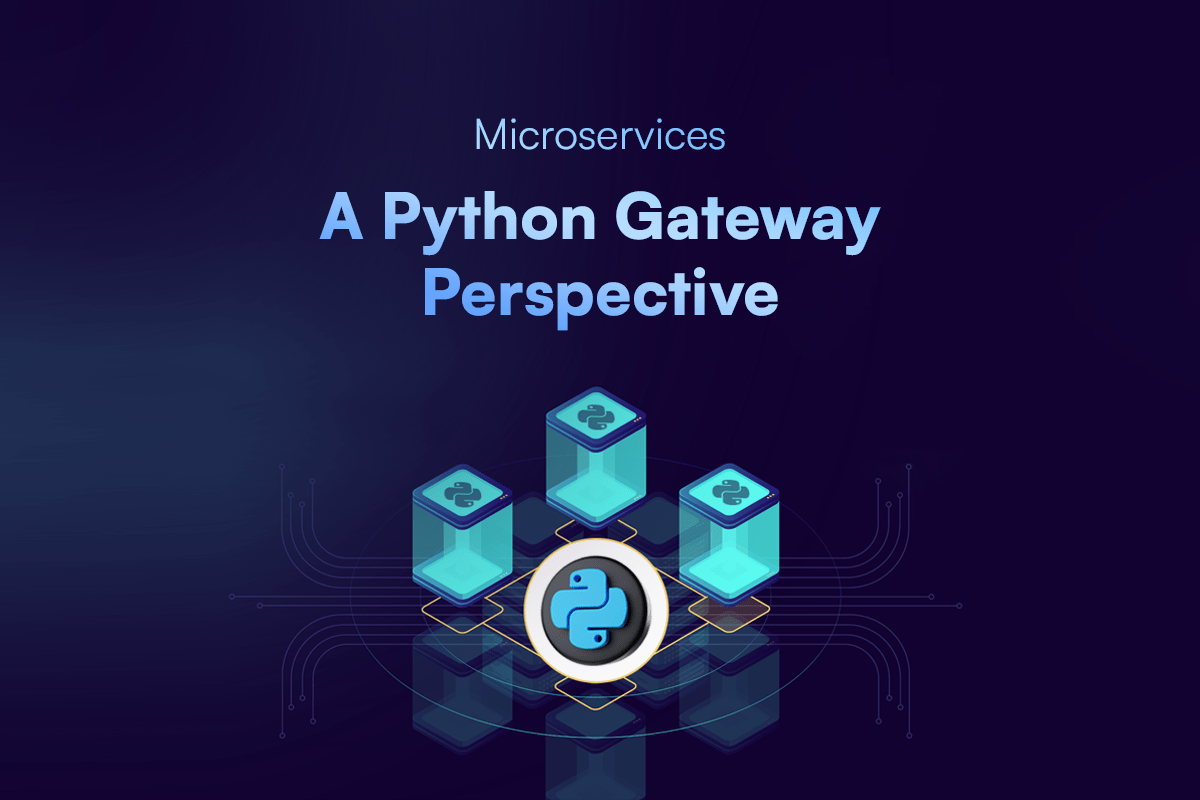Microservice Architecture With Python Gateway

What is Project Architecture ?
“Project architecture” typically refers to the overall design and structure of a project. This term is commonly used in the context of software development, but it can also apply to various other types of projects, such as construction, engineering, or business initiatives.
In software development, project architecture involves making high-level decisions about how the system will be organized and how its components will interact. This includes decisions about the choice of programming languages, frameworks, databases, and other technologies, as well as the overall structure of the codebase. The goal is to create a blueprint that guides the development team in building a system that meets the project’s requirements in terms of functionality, scalability, maintainability, and other aspects.
Some key aspects of project architecture in software development include:
- System Components: Identifying the major components or modules that make up the system and defining their responsibilities.
- Data Architecture: Deciding how data will be stored, retrieved, and managed within the system. This involves choosing databases, defining data models, and planning for data access.
- Technology Stack: Selecting the appropriate programming languages, frameworks, libraries, and tools for building the project. This decision often depends on factors like project requirements, team expertise, and scalability needs.
- Communication Protocols: Determining how different components of the system will communicate with each other. This includes defining APIs (Application Programming Interfaces) and communication protocols.
- Scalability and Performance: Planning for the system’s ability to handle growth in terms of users, data, and transactions. This may involve considerations such as load balancing, caching, and optimization strategies.
- Security: Incorporating security measures to protect the system from unauthorized access, data breaches, and other security threats.
- User Interface (UI) and User Experience (UX): Designing the user interface and overall user experience to ensure that the system is user-friendly and meets the needs of its intended audience.
- Testing and Quality Assurance: Planning for testing strategies, including unit testing, integration testing, and system testing, to ensure the reliability and quality of the project.
Types of Project Architecture:
- Monolithic Architecture: All components of the software are tightly integrated into a single executable or deployment unit. Changes in one part may affect the entire system.
- Microservices Architecture: Microservices Architecture involves decomposing an application into discrete, autonomous services that interact via APIs. Each service is dedicated to a distinct business function, fostering modularity and facilitating scalability and maintainability.
- Service-Oriented Architecture (SOA): Similar to microservices but with a focus on services that communicate with each other over a network. Services are loosely coupled and can be developed and deployed independently.
Introduction to Microservice Architecture
Microservices architecture is an approach to designing and building software systems as a collection of small, independent services, each focused on a specific business capability. Instead of developing a monolithic application where all components are tightly integrated, microservices promote the decomposition of the system into modular and independently deployable services. Every service functions as its own entity, establishing communication with others via clearly defined APIs (Application Programming Interfaces). Here’s an introduction to microservices architecture:
Key Characteristics:
- Modularity:
- Microservices break down a system into small, independent, and loosely coupled services. Each service is responsible for a specific business function or capability.
- Independence:
- Services are developed, deployed, and scaled independently. This allows for flexibility in technology choices, development cycles, and maintenance.
- Decentralized Data Management:
- Each microservice can have its own database, and data consistency is maintained through communication between services. This decentralization avoids a single, monolithic database.
- Autonomous Development Teams:
- Development teams are organized around specific microservices, promoting autonomy. Each team can work on its service without being tightly coupled to other teams.
- Scalability:
- Microservices architecture allows for independent scaling of services based on demand. Unlike monolithic architectures, where scaling typically requires duplicating the entire application, microservices allow for scaling individual components independently, enhancing efficiency and resource allocation.
- Resilience and Fault Tolerance:
- Failure in one microservice doesn’t necessarily impact the entire system. Services can be designed to handle faults gracefully, providing resilience to failures.
- Technology Diversity:
- Different services within a microservices-based system can be developed using diverse technology stacks based on the specific requirements of each service.
- Rapid Deployment:
- Microservices can be deployed independently, enabling faster and more frequent releases. This supports continuous integration and continuous delivery (CI/CD) practices.
Components of Microservices Architecture:
- Service:
- The fundamental building block of microservices architecture. Each service represents a specific business capability and operates independently.
- API Gateway:
- Serves as a single entry point for clients to interact with various microservices. It handles routing, composition of responses, and other gateway-related concerns.
- Service Registry:
- Keeps track of the location and availability of each service within the architecture, facilitating service discovery.
- Event-Driven Communication:
- Microservices often communicate through events or messages. This asynchronous communication enables services to react to changes or events in other services.
- Containerization and Orchestration:
- Containers (e.g., Docker) are often used to package and deploy microservices. Orchestration tools (e.g., Kubernetes) help manage the deployment, scaling, and monitoring of containers.
- Centralized Configuration:
- Configuration settings are often managed centrally to ensure consistency across microservices.
Benefits:
- Scalability and Flexibility:
- Microservices allow for independent scaling of services, providing flexibility to adapt to changing workloads.
- Rapid Development:
- Autonomous teams can work concurrently, accelerating development cycles and time-to-market.
- Resilience and Fault Isolation:
- Failures in one service do not necessarily affect the entire system, enhancing resilience and fault tolerance.
- Technology Diversity:
- Different services can use technologies best suited to their specific requirements.
- Continuous Deployment:
- Independent deployment of microservices supports continuous integration and delivery practices.
Challenges:
- Increased Complexity:
- Microservices introduce complexities in terms of inter-service communication, data consistency, and system monitoring.
- Operational Overhead:
- Managing a larger number of services can increase operational challenges, requiring robust monitoring and management tools.
- Data Consistency:
- Maintaining data consistency across microservices can be challenging, and strategies like event-driven architectures or distributed transactions may be required.
Why Microservice Architecture?
- Scalability:
- Independent Scaling: Microservices allow you to scale different components independently based on their individual needs. This can lead to more efficient resource utilization.
- Flexibility and Agility:
- Independent Development: Microservices enable independent development and deployment of services. This allows different teams to work on separate services simultaneously, promoting agility and faster time-to-market.
- Technology Diversity: Each microservice can be developed using the most suitable technology stack for its specific functionality, promoting flexibility in technology choices.
- Fault Isolation:
- Isolation of Failures: If one microservice fails or experiences issues, it doesn’t necessarily affect the entire system. Other services can continue to function independently, enhancing fault tolerance.
- Ease of Maintenance:
- Isolated Codebases: Each microservice typically has its own codebase, making it easier to maintain and update without impacting other services.
- Autonomous Teams: Development teams can be organized around microservices, with each team responsible for a specific service. This autonomy can lead to faster development cycles and better responsiveness to changes.
- Continuous Delivery and Deployment:
- Independent Deployment: Microservices can be deployed independently of each other. This facilitates continuous delivery and allows you to release updates to specific services without affecting the entire system.
- Improved Fault Tolerance:
- Resilience to Failures: The failure of one microservice doesn’t necessarily bring down the entire system. Services can be engineered to handle failures gracefully, incorporating fallback mechanisms to ensure robustness and uninterrupted operation.
- Scalable Development Teams:
- Team Autonomy: Different development teams can work on separate microservices, reducing the dependencies between teams and allowing for parallel development efforts.
- Easier Adoption of New Technologies:
- Technology Agnosticism: Microservices allow each service to be developed using the most suitable technology. This makes it easier to adopt new technologies without overhauling the entire system.
- Improved Fault Isolation:
- Isolation of Faults: Issues in one microservice are less likely to propagate to other parts of the system, making it easier to identify and fix problems.
Building on the foundation of our previous blog discussing ‘Monolithic VS Microservice‘, where we delved into the contrasting paradigms shaping modern software development.
Key Characteristics of Microservices Architecture with Python:
- Modularity:
- Microservices are independent entities, each responsible for a specific business function.
- They can be developed, deployed, and scaled independently.
- Decentralized Data Management:
- Each microservice manages its own data storage, ensuring data autonomy.
- This reduces dependencies on a central database and allows for better data isolation.
- Communication via APIs:
- Services communicate through lightweight APIs.
- RESTful APIs are commonly used for their simplicity and flexibility.
- Resilience:
- Failure in one microservice does not bring down the entire system.
- Resilience is achieved through redundancy and graceful degradation.
Conclusion:
The blog introduces the concept of project architecture in software development and delves into Microservices Architecture as a modern approach. It highlights the benefits of Microservices, such as scalability, flexibility, fault isolation, and easier maintenance. The conclusion emphasizes the advantages of Microservices Architecture in promoting agility, rapid deployment, and resilience to failures, making it a compelling choice for modern software development.
Stay tune with us for our next blog on “Setting Up Django as the Gateway“





